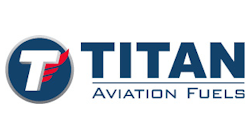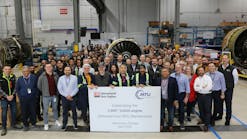Supply Side
Avfuel’s Sincock sees an evolving market for FBOs, fuel distribution
By John F. Infanger
January 2002
Craig Sincock
ANN ARBOR, MI — As part of our ongoing series looking at the fixed base operator segment of the industry, AIRPORT BUSINESS recently visited with Craig Sincock, president of Avfuel Corporation, to discuss trends in the service sector. Here’s an edited transcript of the interview.
AIRPORT BUSINESS: What can we expect in the months ahead from suppliers in the aftermarket?
Sincock: Fuel suppliers to the general aviation
industry are in a situation similar to many other industries in North
America. The North American economy is a mature economic model, and normally
what you see is the strong companies that are meeting customer demands
are the ones that tend to grow and survive.
What you see in the supply of fuel for FBOs
is that there are a number of choices still out there, and those choices
are the result of 15, 20 years of various companies developing into the
stronger ones to serve the industry.
Some companies in the past 10, 15 years
have gotten out of the business, and others have evolved.
The process of evolution for us has been
one of internal growth through acquisition. We’ve cornered seven
acquisitions since the late ’80s, with different geographic areas
and strengths. Most of them have been in the fuel supply side; some have
been in insurance.
AB: What are you hearing from your dealers in the aftermath of the tragedies of September 11th?
Sincock: One of the biggest needs you have
to provide for is communication. When events happen, you have to communicate
and do so frequently. FBOs need the information on a timely basis to run
their businesses.
I just returned from a week-long visit to
dealers. As we progressed through the week, we visited five or six heavy-business
jet locations, FBOs. Their sales were similar to a year ago. On the other
hand, we stopped at a couple of resort destinations, and their business
was down slightly from the previous year.
Regarding the avgas segment, it’s been
off a significant amount since September 11. That’s reflecting the
changing regulatory environment and the economy. We would forecast that
over the next few years avgas should be somewhat of a flat product, once
we get out of this period where there are new regulations to deal with.
We’re forecasting jet demand to be
increasing over the next one, three, ten years. That coincides with projections
for growth with the business fleets.
AB: The grounding of the fleet had serious implications for many of the smaller aviation service companies, in particular. How is your business responding to the needs of these smaller firms?
Sincock: Actually, we sat down the week
after September 11th and tried to anticipate what some of the needs would
be in the aviation community. And we believe one of the biggest needs,
and one of the areas hardest hit, was flight schools. We have announced
that we will work with any of the Avfuel flight schools or other flight
schools in the country on some extended terms for fuel purchases.
The need to train pilots for this industry
is not going to go away. Business and general aviation are not going away.
Our insurance division, Avsur-ance, has
had a very meaningful increase in the number of flight schools for which
they handle insurance in the last year. We are insuring flight schools
than ever before.
What we’ve been strategizing on in
the last year has been how to fill out the fuel side of the equation,
both domestically and internationally. We happened to be doing both at
once, with the Texaco acquisition and a global alliance with Shell Aviation.
AB: Regarding insurance, what are you seeing out there?
Sincock: The biggest topic has been coverage
of war risks, and many people have war risk coverage in their policy that
was cancelled soon after September 11. In order to have that coverage,
most likely they’ll have to buy it back at a more expensive rate,
reflecting the current situation.
We’ve had numerous flight departments
that have multiple corporate-configured type aircraft call and ask for
war risk coverage, which we can provide.
AB: What is your current perspective on the U.S. economy?
Sincock: My vision of where the economy
has been and might go may differ from others, but I saw the recession
happening earlier and see it lasting longer. People were looking for a
downturn for a quarter or two, but if you look at historic charts, downturns
are normally longer than a quarter. It’s obvious now in hindsight
that we were off in many sectors of our economy before September 11.
The events of September 11 probably extended
the downturn a year. My vision would be that I would expect to see some
recovery build in the latter half of 2002 and continuing to build.
We’re still not in a bad economy. These
are tighter times, and tighter times call for companies that are more
nimble, that are more creative, that are more responsive to customers.
AB: You are both a supplier and a general aviation user (Citation XL). Looking at FBOs today versus 15 years ago, where do you see this segment of aviation evolving?
Sincock: From my observation point, the
businesses today are run in much more business-like manners, procedures,
and systems. That has been an evolution over the past ten years.
The people in aviation today more than ever
are analytical about what their niche is at their particular airport,
and how they’re going to make the best benefit of that.
If you look out over ten more years, the
FBO businesses will become even more professionally run, requiring even
more knowledge, and they will also be servicing more business jets than
they ever have. The striking difference that I can see is that the avgas
business is becoming less of a percentage of the overall FBO mix every
year.
AB: Watching the dynamics in aviation since September 11, there has been a jump in interest in business aircraft and fractionals. Do you see this increase as a temporary spike or something more long-term?
Sincock: I think the dynamics after September
11 are going to be supportive of business aviation. There might be a short-term
bubble of interest from people wanting their own business jet to fly,
but I think it’s really part of a long-term trend.
Do I see it really increasing over what
was projected six months ago? I’m not sure that will happen, because
that projection sees the doubling of business aircraft in ten years. If
it even meets that type of growth, it will be fantastic growth for that
market segment. How that relates to FBOs is, the more business aircraft
that are out there flying, the more ground support services they’re
going to need. So I think it plays very positively in the forecast for
FBOs.
While you might see flight training being
flat, or the avgas burners flat, the end result is the FBO might see the
flattening of some segments of their business but an increase in the others.
AB: What are your thoughts related to the increased security requirements following September 11th?
Sincock: We’re not in favor of any
increase in bureaucracy that does not help control the situation.
I do believe that the aviation industry
needs to continue to have a voice in Washington so that they understand
clearly the aviation business, from Part 135 to 91 to flight training,
and understand the system that’s in place so that when they make
decisions they know how they’re affecting everyone.
AB: Are there differences today in what FBOs are asking of you as a supplier?
Sincock: I think they’re always evolving
in what they’re asking of all suppliers. As businesses become more
sophisticated in their approach, it is important that any vendors supplying
those businesses meet the new needs.
We realized a long time ago that we had
to be more than providing fuel delivery, a credit card machine, and a
sign.
Avfuel up to 800 dealers
This fall, Avfuel purchased the Texaco general
aviation division in 14 states, about half the business that Texaco had.
According to Avfuel president Craig Sincock, initially the FBOs will operate
under the Texaco banner, but will be phased into the Avfuel banner over
a period of several months.
The move came in the midst of merger talks
between Chevron and Texaco. The merger was subsequently approved by the
Federal Trade Commission.
The acquisition fills in the geographic
areas that Avfuel was targeting for growth, according to Sincock. It brings
the Avfuel aftermarket reach to 800 dealers.







